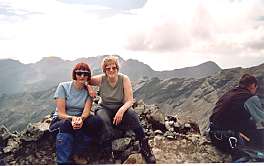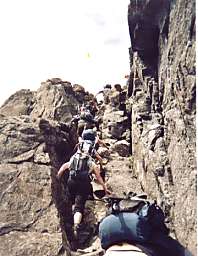Sgurr nan Gillean, Skye
Helen Rose Hill Diary June 2004

On the Cuillin Ridge on Skye, there are only a few mountains which can be climbed by hill walkers without some technical support. I have already written about Sgurr Alistair and I have also walked to the top of Blaven and Bruach na Frithe. The only mountain left for me to walk up with some scrambling within my ability was Sgurr nan Gillean and I have had ambitions to climb it for some years now. The opportunity arose at the May Bank holiday weekend when the Glasgow HF Outdoor club arranged a weekend in Skye and Stephen agreed to lead some walks.
We arrived in Skye in glorious weather and stayed in Broadford, a village on the coast, for the weekend. There were more than forty members of the club on the weekend, some staying in the Hostel and others at Bed and Breakfast. It was difficult to make contact with everyone as we fragmented into smaller groups on the walks of our choice. Stephen had considered Sgurr nan Gillean for Sunday, weather permitting, of course, and a small group of about nine went with him on Saturday to climb two Corbetts ( hills from 2.000 to 3,000 feet high). It was a lovely day out in good company and glorious weather and being Skye, the walk was a mixture of rough ground , scree and some scrambling on gabbro rock. This rock is good to scramble as it has a rough texture and is not slippery but is unfortunately like sandpaper and can damage clothing and skin. Gabbro is an intrusive igneous rock that develops from mafic magma and whose mineral crystals are course. Mineralogically, this rock is identical to basalt which is fairly nearby in forming an area from the Giants Causeway in Ireland under the sea to Staffa in Scotland, both areas I have previously written on. Anyway, enough of the geology lesson.The big day of the weekend was the same group tackling Sgurr nan Gillean. We parked at Slighachan and the mountain was in full view in all it’s splendour. I approached the walk with trepidation as I knew that the mountain had been considered unclimbable until 1836 and I wondered how a basic hill walker with poor scrambling skills would manage.

The first part of the walk was on a well defined path leading over the Allt Dearg Mor and eventually the path becomes very faint as Coire Riabhach is entered. This corrie looks impenetrable with a high rocky ridge but hopping over boulders it is on to a scree filled gully and eventually up to the col where the real fun starts. The final summit ridge looks like a giant staircase and there is much steeping up rocks but the we soon reached an area of rock which seemed impossible. The crest seemed too difficult for us poor scramblers but the brave Sue forged ahead up some rocks and after various turns ended up on top of this difficult part. The rest of us followed, albeit very slowly and tentatively and reached the final airy crest which had to be covered carefully as there was a step across a void on to more rock and then up to the final, very small, summit.
On the top, we had a second lunch and looked over the Cuillins to climbers on the peaks such as Am Basteir. Elaine sat perilously on the edge of the summit dangling her feet over the edge! This is not a walk for the faint hearted but there is a marvellous sense of achievement to reach the summit after an airy scramble. The descent seemed easier but we were careful as more accidents happen on the descent than at any other time. It was a great day out in good weather and in good company and we encouraged each other to complete the climb as a team. It was then down to the Climbers Bar in Slighachan Hotel for a good meal and a few refreshments as we were all elated. Many thanks to Stephen for leading us on this walk and ably assisting us in the difficult parts of the scramble.

This week I hope to climb my 200th Munro so one day I will have to return to Skye to somehow scramble on the more difficult Munros.
Coming attractions; Lairigh an Laoigh, Fannaichs and a walk in Ecuador
E mail me at helenrose52@hotmail.com
Thanks to Frances Rickus for the photos
.





